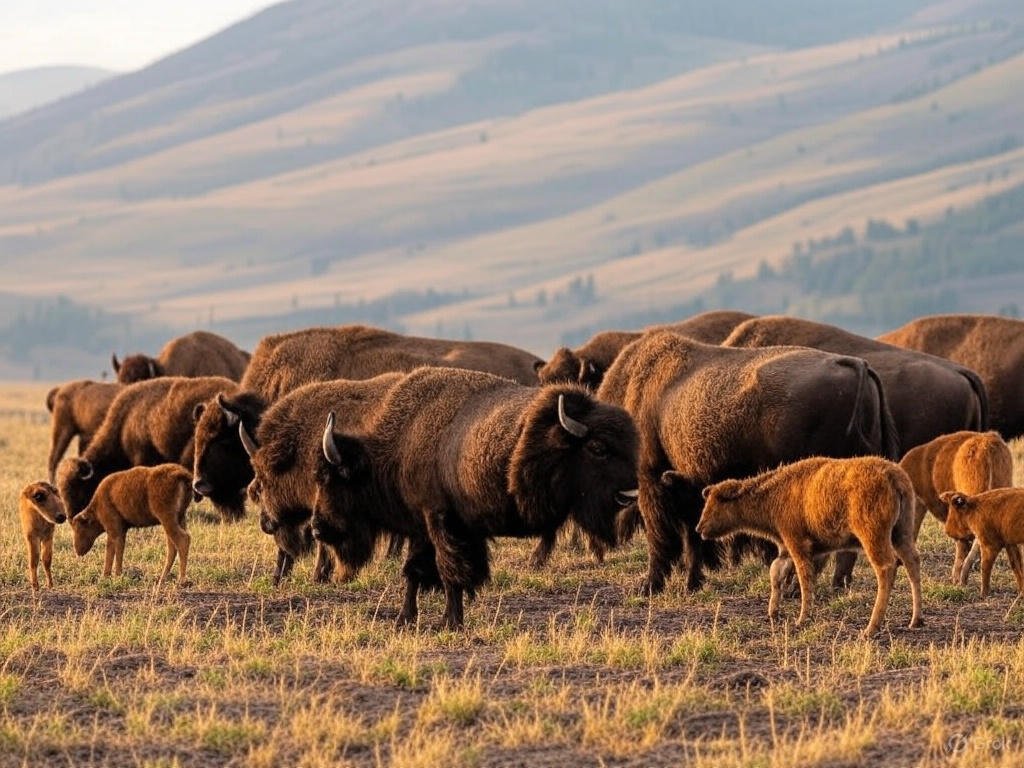The Yellowstone bison population, estimated at 5,000–10,000 in 2024, stands as a testament to one of America’s greatest conservation successes. As one of the last genetically pure, free-roaming herds in North America, the Yellowstone bison herd embodies the park’s ecological and cultural heritage. Yet, its growth sparks heated debates, exemplified by the ongoing Yellowstone bison herd lawsuit, which challenges the 2024 Bison Management Plan. This plan aims to balance population expansion with Montana’s concerns about disease and land use. In this article, we’ll explore the historical recovery of the bison population in Yellowstone, current estimates, management challenges like culling and brucellosis, and conservation efforts to secure the herd’s future. Join us as we delve into the complex dynamics shaping Yellowstone’s iconic bison.
Historical Trends: From Near Extinction to Recovery
In the late 19th century, the bison population in Yellowstone teetered on the brink of extinction. By 1902, fewer than 25 bison remained in the park, a stark contrast to the millions that once roamed the Great Plains. Overhunting and habitat loss drove this decline, but Yellowstone National Park became a sanctuary for the species. Early conservation efforts, including park protection and breeding programs, sparked a slow recovery. By the mid-20th century, the herd grew to several hundred, and by the early 2000s, it reached 4,000–5,000, cementing Yellowstone as a bison stronghold. The herd’s genetic purity, free of cattle hybridization, makes it a vital asset for global bison conservation. Today’s management strategies build on this legacy, as outlined in our post on The Yellowstone Bison Management Plan: What’s at Stake?.

Current Population: How Many Bison Are in Yellowstone in 2024?
As of 2024, the Yellowstone bison herd numbers between 5,000 and 10,000, according to National Park Service (NPS) estimates. This range fluctuates seasonally and due to management actions like culling and relocation. The herd roams across iconic areas such as Lamar Valley, Hayden Valley, and the park’s northern boundaries, where bison often migrate into Montana. The 2024 Bison Management Plan sets a bold target of supporting up to 10,000 bison, a significant increase from earlier caps of 3,000–5,000. However, managing this growth is contentious: in 2024, approximately 400 bison were removed through hunting or slaughter, and 86 entered quarantine for potential relocation. As the NPS notes, “Yellowstone’s bison are a conservation success, but challenges remain.” The Yellowstone national park bison population is one of the largest wild herds, yet its expansion fuels debates over space and disease.
| Year | Bison Population (Approx.) |
|---|---|
| 1902 | 25 |
| 1950 | 500 |
| 2000 | 4,500 |
| 2024 | 7,500 |
Yellowstone bison population growth over time, showing recovery from 25 bison in 1902 to 7,500 in 2024.
Pull-quote: “With 5,000–10,000 bison in 2024, Yellowstone balances growth and conflict.”
Challenges: Brucellosis, Culling, and Migration
The Yellowstone bison population faces significant hurdles, many of which underpin the Yellowstone bison herd lawsuit.
Brucellosis
Brucellosis, a bacterial disease affecting bison and cattle, is Montana’s primary concern in the lawsuit. While the risk of transmission from wild bison to cattle is low—no confirmed cases have occurred—it drives strict management policies. The fear of economic losses for ranchers fuels calls for population control.
Culling
To manage herd size, Yellowstone bison culling is a controversial practice. In some years, up to 900 bison are targeted for removal through hunting or slaughter, particularly when bison migrate outside park boundaries. Critics argue this undermines conservation goals, a key issue in the lawsuit.
Migration
Bison naturally migrate into Montana during winter, seeking lower-elevation grazing. This movement sparks conflicts with ranchers, who view bison as a threat to livestock and property. The resulting push for stricter controls complicates the 2024 management plan’s goals.
These challenges also increase human-wildlife conflicts, as discussed in our post on Staying Safe: Understanding Bison Attacks in Yellowstone, where population size amplifies encounters.
Conservation Efforts: Relocation and the Path Forward
Conservation efforts for the Yellowstone bison population focus on sustainable growth and cultural restoration. The 2024 Bison Management Plan emphasizes relocating disease-free bison to tribal lands, such as the Fort Peck Assiniboine and Sioux Tribes, through rigorous quarantine programs. In 2024, 86 bison were quarantined for this purpose, supporting tribal efforts to restore herds for cultural and food sovereignty. Ecologically, a robust bison population enhances grassland health through grazing, benefiting Yellowstone’s ecosystems. However, the Yellowstone bison herd lawsuit threatens these gains, as it could reinstate stricter population caps. Federal, state, and tribal cooperation is critical to balancing conservation with rancher concerns. For more on the plan’s relocation strategies, see our post on The Yellowstone Bison Management Plan: What’s at Stake?.
Conclusion: Balancing Growth and Sustainability
The Yellowstone bison population’s journey from near extinction to 5,000–10,000 in 2024 is a conservation triumph, yet challenges like brucellosis, culling, and migration persist. The Yellowstone bison herd lawsuit will shape the herd’s future, determining whether the 2024 Bison Management Plan’s vision for growth prevails. Balancing bison conservation with Montana’s ranching interests requires innovative solutions and collaboration. We invite you to explore safety tips in our post on Staying Safe: Understanding Bison Attacks in Yellowstone, dive into the lawsuit’s details in our cornerstone article, or share your thoughts on bison conservation in the comments below. Together, let’s advocate for Yellowstone’s iconic herd.

Felipe M Bastian is a seasoned wildlife conservation expert with a deep focus on Yellowstone National Park’s bison herd and its ecological, cultural, and legal complexities. With over a decade of experience in environmental policy and wildlife management, Felipe has worked closely with park authorities, tribal communities, and conservation organizations to advocate for sustainable bison management practices. His insights into the Yellowstone Bison Management Plan lawsuit, tribal relocation efforts, and bison safety protocols stem from extensive field research and collaboration with stakeholders. Felipe’s writing combines scientific rigor with accessible storytelling, making him a trusted voice on Yellowstone’s iconic species. He holds a Master’s degree in Wildlife Biology and is passionate about preserving the ecological and cultural legacy of bison for future generations.




